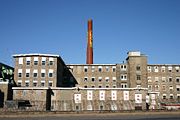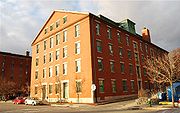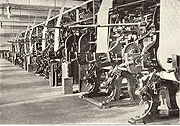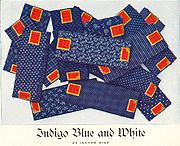
American Printing Company (Fall River Iron Works)
Encyclopedia

Fall River, Massachusetts
Fall River is a city in Bristol County, Massachusetts, in the United States. It is located about south of Boston, southeast of Providence, Rhode Island, and west of New Bedford and south of Taunton. The city's population was 88,857 during the 2010 census, making it the tenth largest city in...
grew to become the largest producer of printed cotton cloth in the United States
United States
The United States of America is a federal constitutional republic comprising fifty states and a federal district...
by the early 20th Century. The company grew as an offshoot of the Fall River Iron Works, established in 1821 by Colonel Richard Borden and Major Bradford Durfee. The company emoloyed several thousand workers at its peak during World War I
World War I
World War I , which was predominantly called the World War or the Great War from its occurrence until 1939, and the First World War or World War I thereafter, was a major war centred in Europe that began on 28 July 1914 and lasted until 11 November 1918...
.
Fall River Iron Works

Fall River
-Cities and towns:In Canada:*Fall River, Nova ScotiaIn the United States:*Fall River, Kansas*Fall River, Massachusetts, the largest city with this name*Fall River, Tennessee*Fall River, Wisconsin*Fall River County, South Dakota-Rivers:In Canada:...
grew out of the developments made in nearby Rhode Island beginning with Samuel Slater
Samuel Slater
Samuel Slater was an early English-American industrialist known as the "Father of the American Industrial Revolution", or the "Father of the American Factory System" because he brought British textile technology to America. He learned textile machinery as an apprentice to a pioneer in the British...
at Pawtucket in 1793. The first textile mill in Fall River was built in 1811. Several more would follow between 1813 and 1821, along the "falling" Quequechan River
Quequechan River
The Quequechan River , is a river in Fall River, Massachusetts that flows in a northwesterly direction from the South Watuppa Pond to the Taunton River. The word Quequechan means "falling water" in Wampanoag, hence the city's name....
for which the city was named.
In 1821, Col. Richard Borden established the Fall River Iron Works, along with Maj. Bradford Durfee at the lower part of the Quequechan River
Quequechan River
The Quequechan River , is a river in Fall River, Massachusetts that flows in a northwesterly direction from the South Watuppa Pond to the Taunton River. The word Quequechan means "falling water" in Wampanoag, hence the city's name....
. Bradford Durfee was a shipwright, and Richard Borden was the owner of a grist mill. After an uncertain start, in which some early investors pulled out, the Fall River Iron Works was incorporated in 1825, with $200,000 in capital. The Iron Works began producing nails, bar stock, and other items such as bands for casks in the nearby New Bedford
New Bedford
-Places:*New Bedford, Illinois*New Bedford, Massachusetts, the most populous New Bedford**New Bedford Whaling National Historical Park*New Bedford, New Jersey *New Bedford, Ohio*New Bedford, Pennsylvania...
whaling
Whaling
Whaling is the hunting of whales mainly for meat and oil. Its earliest forms date to at least 3000 BC. Various coastal communities have long histories of sustenance whaling and harvesting beached whales...
industry. They soon gained a reputation for producing nails of high quality, and business flourished.
By 1833 Fall River
Fall River
-Cities and towns:In Canada:*Fall River, Nova ScotiaIn the United States:*Fall River, Kansas*Fall River, Massachusetts, the largest city with this name*Fall River, Tennessee*Fall River, Wisconsin*Fall River County, South Dakota-Rivers:In Canada:...
had 13 cotton mills, employing 1,200 people, with 31,000 total spindles (a common measure of total spinning capacity) and 1,050 looms. The Iron Works would continue to play an important role in the early development of the textile industry in Fall River.
By 1840, the Iron Works employed about 250 people and produced over 3.8 million pounds of nails, as well as 950 tons of iron hoops and 400 tons of castings. By 1845, the company was valued at $960,000. In 1827, Col. Borden began regular steamship service to Providence, Rhode Island
Providence, Rhode Island
Providence is the capital and most populous city of Rhode Island and was one of the first cities established in the United States. Located in Providence County, it is the third largest city in the New England region...
.

In 1848, the Fall River Iron Works constructed an office and warehouse building along the waterfront in Providence, Rhode Island
Providence, Rhode Island
Providence is the capital and most populous city of Rhode Island and was one of the first cities established in the United States. Located in Providence County, it is the third largest city in the New England region...
and retained the location until 1881. This building is still standing, and is now occupied by the Rhode Island School of Design
Rhode Island School of Design
Rhode Island School of Design is a fine arts and design college located in Providence, Rhode Island. It was founded in 1877. Located at the base of College Hill, the RISD campus is contiguous with the Brown University campus. The two institutions share social, academic, and community resources and...
. Providence Site Info
American Print Works
In 1824, Andrew Robeson, arrived from ScotlandScotland
Scotland is a country that is part of the United Kingdom. Occupying the northern third of the island of Great Britain, it shares a border with England to the south and is bounded by the North Sea to the east, the Atlantic Ocean to the north and west, and the North Channel and Irish Sea to the...
and established the first Print Works in the City, a segment of the industry that Fall River would in later years come to dominate.
The American Print Works was established in 1835 by Holder Borden, uncle of Colonel Richard. Located along the shore of Mount Hope Bay
Mount Hope Bay
Mount Hope Bay is a tidal estuary located at the mouth of the Taunton River on the Massachusetts and Rhode Island border. It is an arm of Narragansett Bay. The bay is named after Mount Hope, a small hill located on its western shore in what is now Bristol, Rhode Island. It flows into the East...
, its location would prove ideal as ocean-going ships were able to dock at the company's doorstep. In the 1840s, the railroad would be extended to the Print Works site, adjacent to the steamship pier with regular service to Providence and New York City
New York City
New York is the most populous city in the United States and the center of the New York Metropolitan Area, one of the most populous metropolitan areas in the world. New York exerts a significant impact upon global commerce, finance, media, art, fashion, research, technology, education, and...
. Both the steamships and the railroad were controlled by Colonel Richard Borden, and later his sons and nephews.
In 1853, the nearby Globe Print Works was acquired by Richard Borden
Richard Borden
Colonel Richard Borden was undoubtedly the most influential person in the early history of the city of Fall River, Massachusetts. He co-founded the Fall River Iron Works in 1821, and later built several early cotton mills, as well as the Fall River Line, Fall River Gas Company, the Fall River...
, his brother Jefferson and Oliver Chace
Oliver Chace
Oliver Chace was the founder of several New England textile manufacturing companies in the early 19th century, including the Valley Falls Company, the original antecedent of Berkshire Hathaway, currently one of the largest companies in the world.-Early life:Chace was born on August 24, 1769 in...
.It was renamed the Bay State Print Works, and was later reorganized.
For three generations, the Borden family dynasty would have control or business interests in the City's banks, the gas company, steamboats, railroads and mines. (Lizzie Borden, the famed alleged axe-murderess in 1892 was the great-granddaughter of an uncle of Colonel Richard Borden).
Expansion

Fall River
-Cities and towns:In Canada:*Fall River, Nova ScotiaIn the United States:*Fall River, Kansas*Fall River, Massachusetts, the largest city with this name*Fall River, Tennessee*Fall River, Wisconsin*Fall River County, South Dakota-Rivers:In Canada:...
profited well from the American Civil War
American Civil War
The American Civil War was a civil war fought in the United States of America. In response to the election of Abraham Lincoln as President of the United States, 11 southern slave states declared their secession from the United States and formed the Confederate States of America ; the other 25...
and was in a fine position to take advantage of the prosperity that followed. By 1868, it had surpassed Lowell as the leading textile city in America with over 500,000 total spindles. The American Print Works was set to open a new factory in 1867, when a disastrous fire occurred. It was a major setback for the company, as the final arrangements for insurance were in the process of being completed when the fire happened. However, the American Print Works was soon rebuilt in 1868, bigger and better than it was before.
A few years later during 1871 and 1872, a most dramatic expansion occurred within the City of Fall River
Fall River
-Cities and towns:In Canada:*Fall River, Nova ScotiaIn the United States:*Fall River, Kansas*Fall River, Massachusetts, the largest city with this name*Fall River, Tennessee*Fall River, Wisconsin*Fall River County, South Dakota-Rivers:In Canada:...
, when 15 new corporations were founded, building 22 new mills throughout the city, while some of the older mills expanded. The city's population increased by an astounding 20,000 people during these two years, while overall mill capacity double to more than 1,000,000 spindles. The main product of these mills was print cloth, the vast majority of which, passed through the American Print Works.
By 1876 the city had 1/6 of all New England
New England
New England is a region in the northeastern corner of the United States consisting of the six states of Maine, New Hampshire, Vermont, Massachusetts, Rhode Island, and Connecticut...
cotton capacity, and one-half of all print cloth production. "King Cotton" had definitely arrived. The "Spindle City" as it became known, was second in the world to only Manchester, England.

Panic of 1873
The Panic of 1873 triggered a severe international economic depression in both Europe and the United States that lasted until 1879, and even longer in some countries. The depression was known as the Great Depression until the 1930s, but is now known as the Long Depression...
. The American Print Works failed in 1879, a result of the uninsured losses suffered in the 1867 fire, and was reorganized as the American Printing Company 1880.
At its peak in 1876, the Iron Works employed 600 men. However, just a few years later in 1880, the Iron Works property was divided among shareholders and production of iron ceased soon after, as a result of increased competition from other companies closer to the mines.
In 1887, M.C.D. Borden
Matthew Borden
Matthew Chaloner Durfee Borden , was a textile leader from Fall River, Massachusetts who, in 1880 reorganized the failed American Print Works into the American Printing Company...
, son of Col. Richard gain control of the company's stock, and tore down the old buildings of the iron works, and began the construction of several huge new cloth-producing mills, adjacent to the American Printing Company. These new mills would be known as the "Iron Works Division" of the APC.
Three huge warehouses were also built along the lower portion of Anawan Street, to store the many copper printing rollers required for the production of print cloth, as well as to store customer's orders until they needed them. Mill Number 7 was built in 1905 further up on Anawan Street, and still stands today. The Narrows Center for the Arts occupies one of the former warehouse buildings.
In 1917, the American Printing Company was capitalized at $2,000,000. The Fall River Iron Works, the cloth-producing division of the company and had a huge capacity of 485,288 ring spindles and 12,702 looms. The print works had the capacity to print 125,000 pieces per week.
Decline

By 1910 or so, the Northern mills also faced serious competition from their Southern counterparts due to factors such as lower labor and transportation costs, as well as the South's large investment in new machinery and other equipment. Many northern mills added additional capacity, in a futile attempt to maintain their advantage over the South.
World War I
World War I
World War I , which was predominantly called the World War or the Great War from its occurrence until 1939, and the First World War or World War I thereafter, was a major war centred in Europe that began on 28 July 1914 and lasted until 11 November 1918...
had provided a much needed boost in demand for textiles, and most of the mills in New England
New England
New England is a region in the northeastern corner of the United States consisting of the six states of Maine, New Hampshire, Vermont, Massachusetts, Rhode Island, and Connecticut...
benefited during this time. The post-war economy quickly slowed however and production quickly outpaced demand. The price for print cloth dropped sharply. In 1923, Fall River faced the first wave of mill closures.
In 1924, following the example of some other large northern mills, the American Printing Company built a new plant at Kingsport, Tennessee
Kingsport, Tennessee
Kingsport is a city located mainly in Sullivan County with some western portions in Hawkins County in the US state of Tennessee. The majority of the city lies in Sullivan County...
, and began moving much of its production there. Thousands of Fall River jobs were suddenly lost.
The once mighty American Printing Company finally closed its Fall River mills for good in 1934. In 1937, their huge factory complex on Water Street was acquired by the Firestone Tire & Rubber Company, and soon employed 2,600 people. On October 11–12, 1941, just eight weeks before the attack on Pearl harbor
Attack on Pearl Harbor
The attack on Pearl Harbor was a surprise military strike conducted by the Imperial Japanese Navy against the United States naval base at Pearl Harbor, Hawaii, on the morning of December 7, 1941...
, a huge fire broke out in the old 1860's mill of the print works. The fire was a major setback to the U.S. war effort, as Jesse H. Jones, Secretary of Commerce
United States Secretary of Commerce
The United States Secretary of Commerce is the head of the United States Department of Commerce concerned with business and industry; the Department states its mission to be "to foster, promote, and develop the foreign and domestic commerce"...
, reported that 15,850 tons (31700000 pounds (14,378,878.1 kg)) of rubber was lost in the blaze, valued at approximately $7,000,000.
In March 1973, another huge fire destroyed the former "Iron Works Division" mills. These mills were set to be occupied by the Providence Pile Company. However, the sprinklers had been turned off during the winter because there was no heat in the buildings.
Today, the site is occupied by Borden & Remington Chemical Company(a company with its roots in the 19th century textile industry). Several of the late 19th Century buildings still remain.
In October 2008, Borden & Remington began the demolition of Mill No. 3, which had been vacant and was deemed to be in poor condition. Mill No. 1 was demolished in May 2011.
See also
- Fall River LineFall River LineThe Fall River Line was a combination steamboat and railroad connection between New York City and Boston that operated between 1847 and 1937. It consisted of a railroad journey between Boston and Fall River, Massachusetts, where passengers would then board steamboats for the journey through...
- History of Fall River, MassachusettsHistory of Fall River, MassachusettsFor much of its history, the city of Fall River, Massachusetts has been defined by the rise and fall of its cotton textile industry. From its beginnings as a rural outpost of the Plymouth Colony, the city grew to become the largest textile producing center in the United States during the 19th...
- List of mills in Fall River, Massachusetts
- Old Colony RailroadOld Colony RailroadThe Old Colony Railroad was a major railroad system, mainly covering southeastern Massachusetts and parts of Rhode Island. It operated from 1845 to 1893. Old Colony trains ran from Boston to points such as Plymouth, Fall River, New Bedford, Newport, Providence, Fitchburg, Lowell and Cape Cod...

